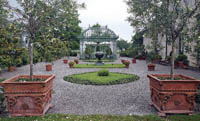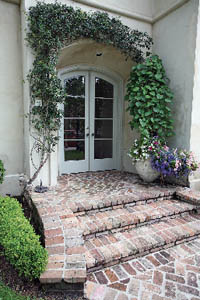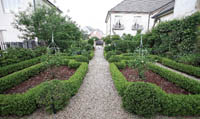Recover, Rebuild, Replant
The Keevers’ lush gardens have been a source of both inspiration and rebirth
 From the outside, it looks like an imposing house in a gated community should—manicured, polished and perfectly positioned to capture sunrise over a golf course, sunset through a vine-covered doubleglass entrance. Step inside and one is transported— instantly without passport or plane travel—to Italy, somewhere south of Rome to be exact.
From the outside, it looks like an imposing house in a gated community should—manicured, polished and perfectly positioned to capture sunrise over a golf course, sunset through a vine-covered doubleglass entrance. Step inside and one is transported— instantly without passport or plane travel—to Italy, somewhere south of Rome to be exact.
The home’s doors open onto a loggia where bricks are laid in a parquet pattern, and the view is of a formal garden filled with perfectly planned boxwood and herbs, beyond stained cement slabs, castiron furniture and bowers of hydrangea. In the center of the area, originally designed by Four Seasons Landscapes, is an antique sculpture head, found in Italy, now mounted on a limestonelike wall that is a fountain.
The house is surrounded by three distinctly different gardens: a formal parterre near the loggia; a flower-filled country garden, where, on the day I visited, a tiny frog had found a perch atop a Resurrection Lily and bees buzzed in the dappled sunlight among colorful snapdragons and blue lobelia; and an Italian garden with an oversized gazebo filled with Meyer lemon, kumquat and lime trees surrounded by urns planted with more citrus bushes and jasmine.
 “Visiting gardens is our love, but gardening is our passion!” explains Bayona’s co-owner Regina Keever, who, with husband Ron, travels the world admiring great gardens and indulging in great food. “After the not-so-exciting-but-definitely-therapeutic weeding, trimming and prepping follows the joyous work of selecting the plants and color palette. Some of our gardens look like adult paint-by-number efforts.” When the hurricanes left four feet of water standing in the ground floor and decimated two gardens, the couple considered selling the house. Then an adjacent lot became available. A conference with neighbors led to a purchase and divide of property that allowed the Keevers to install the formal citrus gardens and to create a doorway from that garden to the dining room.
“Visiting gardens is our love, but gardening is our passion!” explains Bayona’s co-owner Regina Keever, who, with husband Ron, travels the world admiring great gardens and indulging in great food. “After the not-so-exciting-but-definitely-therapeutic weeding, trimming and prepping follows the joyous work of selecting the plants and color palette. Some of our gardens look like adult paint-by-number efforts.” When the hurricanes left four feet of water standing in the ground floor and decimated two gardens, the couple considered selling the house. Then an adjacent lot became available. A conference with neighbors led to a purchase and divide of property that allowed the Keevers to install the formal citrus gardens and to create a doorway from that garden to the dining room.
“The house started as French Provincial. After the storm, it morphed into Southern Italy. I think it’s the citrus trees, or the Pompeian fantasy bathroom,” says Regina, pointing to the elaborately painted bathroom done in deep reds, saturated mustards and black.
“We built the house for entertaining. The floors are now all poured, stained concrete. Because we are both tall, the cabinets, tables and surfaces in the kitchen are raised so we don’t have to bend over and chop, dice, whatever. When we cook, everyone is in the kitchen. The herbs come from the garden, as do many of the fruits and vegetables. I wanted a big table in the dining room to seat lots of people and hold great platters of food.
 “Every room flows into another,” she explains. “Every window, downstairs or up, has a view of a garden.” The gardens are a year-round source of work, joy and inspiration. “December is the time to sow sweet pea and poppy seeds, followed by bare-root roses in January. In late February, wisteria, which wraps over doors, windows and up trellises, azaleas, camellias, sasanqua and bridal wreath come out. The summer survivors, as I call them, are zinnias, caladiums, daylilies and impatiens. They last till August. All summer, we scramble to beat out the birds for the figs that prosper in the hot months. Then in fall, we start all over again.”
“Every room flows into another,” she explains. “Every window, downstairs or up, has a view of a garden.” The gardens are a year-round source of work, joy and inspiration. “December is the time to sow sweet pea and poppy seeds, followed by bare-root roses in January. In late February, wisteria, which wraps over doors, windows and up trellises, azaleas, camellias, sasanqua and bridal wreath come out. The summer survivors, as I call them, are zinnias, caladiums, daylilies and impatiens. They last till August. All summer, we scramble to beat out the birds for the figs that prosper in the hot months. Then in fall, we start all over again.”
In between, there is cooking, wine tastings, laughter and the convivial sorts of meals that rely somewhat on fresh-from-the-garden fruits, vegetables and herbs mixed with international fare reflective of years of travel and restaurant know-how.
